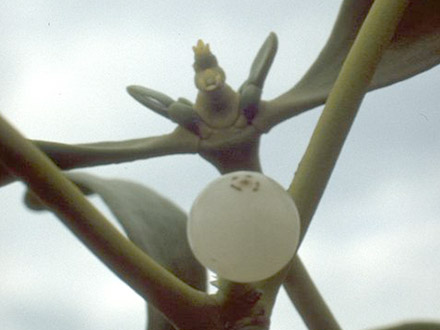Botanical name
Viscum album L.
Family
Santalaceae
Common name
European mistletoe, Common mistletoe, European white-berry mistletoe
Information about the plant
Mistletoe is a semi-parasite that grows mainly on deciduous trees and is widespread in the temperate zones of Europe and Asia. As a semi-parasite, it lives on trees and draws water and nutrients from its host. Mistletoe produces energy-rich organic compounds through photosynthesis via its own green leaves throughout the year. Thus, the host tree is not permanently damaged by the mistletoe.
Once the deciduous trees have shed their leaves in autumn, mistletoe can be seen on poplars, birches, willows, and other deciduous trees. They are spherical subshrubs with a diameter of about 1 meter, resembling a bird’s nest. Green-brown, dichotomously branched twigs spring from a short trunk. The leaves are leathery, with entire margins, and are lanceolate to broadly ligulate. At the end of each forked part, there is a flower-bearing tip. The flowers themselves are rather inconspicuous. Remarkable are the pea-sized white berries with their slimy, sticky contents, which develop from the female flowers. The flowering time is from February to May, and the berries ripen in late autumn. According to an old custom, green mistletoe with the white berries is hung on doors at Christmas to ward off demons.
The Latin name Viscum album may refer to the fact that birdlime (Latin "viscum"= glue) was formerly made from the white berries. It was used to coat twigs to catch songbirds, especially the mistle thrush (Turdus viscivorus), which were considered food.
The German name ‘Mistel’ refers to the fact that the plant reproduces with the help of bird droppings. The berries are eaten by thrushes, whereby the seeds pass through their digestive tract undigested and are thus spread through their droppings.
Medicinally used parts of plants (herbal drug)
The dried herb is used, consisting of younger branches with leaves, flowers, and separated fruits. The drug is imported from the Balkans, Turkey, and Russia.
Constituents of the herbal drug
Mistletoe contains mistletoe lectins (ribosome-inactivating proteins), oligopeptides (viscotoxins 0.05-0.1%), flavonoids, lignans, caffeic acid derivatives, and phytosterols.
Quality of the drug
The quality of mistletoe (Visci herba) is specified in the German Pharmacopoeia (DAB).
Medical applications
Recognised medical use
HMPC: After reviewing the data on mistletoe therapy for cancer, the HMPC concluded that mistletoe cannot be classified as either ‘well-established use’ or a ‘traditional medicinal product’.
ESCOP: Mistletoe has not been reviewed.
Traditional use
Mistletoe is traditionally used, also in combination with other drugs, to support cardiovascular function (traditional use according to Article 16a of Directive 2001/83/EC).
Herbal drug preparations in finished dosage forms
Phytotherapy for palliative treatment of tumours
- Aqueous extract in injection solutions
- Fluid extract in injection solutions
- Cut drug for tea preparation
- Powder in tablets
- Dried extract in pills
- Tincture and alcoholic extracts in drops
- Mother tincture in drops
- Fresh plant juices from mistletoe growing on different host trees in injection solutions
- Aqueous extracts from fermented apple tree mistletoe in injection solutions
Dosage
Prepared drugs: see patient information leaflet.
Tea: Mistletoe tea or oral mistletoe preparations are only appropriate in the traditional sense to support cardiovascular function. Mistletoe herb is a component of various cardiovascular tea blends. Drink 1 cup of mistletoe tea 1 to 2 times daily.
For adjuvant cancer therapy, mistletoe preparations must be administered by injection.
Preparation of a tea
2.5 g of finely cut mistletoe is doused with cold water, allowed to stand at room temperature for 10 to 12 hours and then strained.
Notes
Cancer therapy with mistletoe injections should be administered by experienced doctors. It is not indicated in cases of protein hypersensitivity, chronic progressive infections (e.g. tuberculosis), and acute inflammatory or highly febrile illnesses.
Mistletoe herb must not be used in any form during pregnancy and lactation.
Side effects
Injection of mistletoe preparations may cause chills, fever, headaches, angina, cardiovascular disorders, allergic reactions, and inflammatory irritation of the veins. Subcutaneous nodules may form at the injection site. It can also cause lymph node swelling, trigger inflammation, and lead to symptoms of increased intracranial pressure in cases of brain and spinal cord tumors.
Interactions
Mistletoe should not be combined with other immune stimulants.
References
Herbal drug monographs
HMPC (2013)
Further literature
Commentary on the German Pharmacopoeia (Mistletoe)


